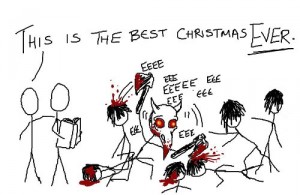Notes and slides from my presentation at Develop 2012, on what video games should be stealing/learning from other, geekier sorts of game.
Who am I and what on earth do I do:
I’m Mary, and I’m a massive nerd. Mostly I design live games, mostly involving NERF guns. The biggest game I run is called, imaginatively, Zombie LARP, and it involves live action role playing and zombies.
Zombie was born when Grant, who’s drawn these slides, and Chris, who appears in them pretty frequently, started shooting each other with NERF guns in halls at uni. They invited a couple of us round to their house, and gave us NERF guns, and pretended to be zombies. My first Zombie LARP death happened in their kitchen, as I fumbled to reload a Nitefinder. It was awesome.
The games society at uni kindly let us run it at the 24-hour roleplay. Every year they take over a building at university for 24 hours and play games. Board, card, video, live, war, tabletop – all sorts. That’s where we got our start – playing at 3am with about 15 exhausted geeks hyper on Tesco’s own brand energy drinks. Now, six years later, we run huge games for 150-odd people in abandoned buildings.
But I also play and write about – and sometimes for – video games. And I see a lot of the development processes that we go through with live games and tabletop systems mirrored in what video games are trying to do. So what I want to do today is talk a little about the lessons I’ve learned from wiser geeks than me, playing older, more traditional, and frankly much more nerdy games. Starting with the geekiest of all: Dungeons and Dragons.
What Dungeons and Dragons can teach us about story in games:
The standard game of D&D is a really good model for looking at different sorts of narrative in games. There are four types. Not every game has all of them, but they all have at least one.
First up: the Told story. This is the one the Dungeon Master is actually trying to tell. She might have a whole host of carefully planned and pre-written events that culminate in a fantastic climax. Or, like a friend of mine, she might just have written “BLAM! IS ADVENTURE” on a piece of paper and be totally making it up. But she’s in control of the story, she’s giving out information and framing scenes to create something that adds up. She controls NPCs, she’s the ultimate arbiter of conflicts, she creates the narrative arc and leads the players through it.
Obviously a fair few video games aren’t really interested in this sort of story, or only in very simple versions of it. Things like “Angry Birds invade pig houses” or “Hungry monster wants hard-to-reach candy”. But for others, the story is a big part of the game – the designers want to convey a narrative through the game experience. That’s Told story.
Secondly, the Experienced story. This is essentially the narrative of the time you spend playing, not the game per se. It includes the infrastructure – the stuff around the edges of the game like phoning for pizza or people being late. Interruptions are part of this, and so are stupid out of character jokes, and those times when the conversation wanders off a long way from where the action is. As Michael Brunton-Spall pointed out on Twitter, it also includes things like critical hits and fumbles, where an unusually lucky or unlucky result on the dice leads to a different story being created. Generally this isn’t a story that ever gets told, as such – it gets experienced, and then your brain chops it up into representative chunks for you to remember.
In video games, as well as taking in interruptions and stuff going on outside the game at the same time, the experienced story includes loading screens, and glitches, and crashes, and dying. My experienced story in Mirror’s Edge, for instance, was about a girl called Faith who kept running off buildings and falling unceremoniously to her death. Assassin’s Creed is a series that copes very well with this stuff, by keeping the player in the story world even during loading and dying and other nominally out-of-game states. Rogue-likes make a virtue of the repetition.
And then, there’s the Interpreted story.
Interpreted can’t exist without Told stories. But the theory goes like this:
- a story doesn’t exist until it’s experienced. That goes for games, films, and books, too. Otherwise it’s just an object.
- the story is always filtered through the individual understanding of the player involved. Because they’re human, they’ll have different ideas and associations and resonances, a different understanding of what the various bits of the story might mean.
- so the interpreted story is different for everyone. It changes in different contexts.
In D&D, that turns up most obviously as players getting the wrong end of the stick about something. Not realising the monster is actually being controlled by the supposedly friendly NPC, or deciding that *this* insignificant detail is actually the thing they should go chasing after for the next three hours. But it also covers players finding new levels of complexity in a GM’s narrative, interpreting coincidences as deeply meaningful – or things that are meant to be meaningful as coincidences.
Authors can’t control audience interpretations of their stories – intent isn’t magic – and there will always be a difference between what a creator wants to say with a story, and what people take from it. Even if only because historical and individual context changes. But it’s true for video games that meaning is collaboratively created, it arises from the joining of a storyteller and a story player, and that sometimes the interpreted story can work against the intention of the creator in unexpected ways – or can reinforce it.
Look at the reams of interpretation that’s been done on Silent Hill, or the readings of Resident Evil’s racial politics. There are elements placed there by the designers that have been drawn out by players to reveal a wider, deeper, perhaps more problematic – perhaps unintended – story. Those readings aren’t invalid just because they might not be intended.
Finally, there’s emergent story. Emergent story is my favourite kind. It’s not quite the same thing as emergent gameplay, which in D&D terms would be doing something like making a Grease wizard who only casts Grease and Fireball spells, and is very good at bringing down monsters with low Dex scores like T-Rexes.
Emergent story is what happens when players get to futz around directly with the mechanics of a game, within a framework. It’s the little, unexpected moments that aren’t directly intended by the creator, but that can be the most memorable bits of the game: roleplaying conflicts among the party, for instance. The decision by one player to take the skill Crafts: tailoring, and then go on a quest to acquire the finest suit in all the land. A group of players deciding to jack in the monster hunting business and go be pirates. Or the moment when the characters react to the death of one of their number.
Video games are not great at this. Live games are brilliant at it, and tabletop is not far behind. At Zombie, this is the sort of stuff we thrive on. We deliberately designed the system to encourage emergent stories – to be flexible enough and simple enough for spontaneous moments of awesome, which is what we originally called it. But the flip side of doing that is that for some players, those moments never happen – and if you fail to balance that right, it can make for boring play.
The games that are doing emergent story well right now are MMOs – Eve online, in a huge way, but also WoW and others. Minecraft & the Sims manages a much more individual emergence – the action of a single player in a procedurally generated world – and perhaps the current pinnacle of emergent story in gaming is Day Z. But this is such a young area in video games. There’s so much more to do.
What Dogs in the Vineyard can teach us about ludonarrative dissonance:
Ludonarrative dissonance is a gloriously useful term that describes conflict between game system & game story. Dogs in the Vineyard is a game where you play, basically, deeply religious teenage Mormon virgin gun-toting priests in the wild West. The whole system is built around the setting, and the types of stories you can tell with it. It provides a way for storytellers to building towns that have heresies within them, and giving your players the tricky job of resolving them. It’s a game about hard moral choices, and not having the right answer, and not being sure, and risking things – gambling your reputation and the happiness, security, and lives of others on being right, when there is no “right” to be.
The system you use for conflict resolution is based around stakes, and bidding. It feels a little like poker. You might start out arguing, verbally, and you roll a pool of dice that runs off your verbal skills, and then you have an argument – you bid dice from your pool against dice from your opponent’s pool, till one of you can’t beat the other. Then your choices are to back down, or to escalate. You could move up to physical violence, or even gunfighting, which gives you a new pool of dice – but your opponent can escalate too, and then you’re risking a lot more damage when everything shakes down.
The way that plays out in practice is thematically consistent with the game story – because the game story is running off quite a limited set of themes and ideas. The stories all work off trade-offs, being unsure, raising the stakes because the option of doing nothing isn’t an option at all. There’s no dissonance – the game’s smooth, the experience is unified – because the system, the setting and the story have been developed together, organically. The textures mesh. The experience feels continuous. It’s a deeply fulfilling, immersive, gratifying game to play if you have a half-decent games master, because all the pieces work together.
There are some video games that do this beautifully – Manhunt, for instance. Project Zero. Spec Ops: the Line, interestingly. And then there are games like GTA4, LA Noir, Uncharted – games where the character you control can do things that the cut-scene character just wouldn’t consider. The character that you’re creating and inhabiting as a player is different to the one in the cut-scenes – which breaks immersion, badly, but also breaks the player’s creative, narrative play by disregarding the choices they’ve made. That stops the play experience hanging together, and can make the player feel less invested in the world – after all, if their actions mean nothing once the cinematic starts, then the imaginitive “work” they’re putting into the game isn’t being respected.
What Mage: the Ascension Mind’s Eye Theatre LARP can teach us about ownership:
Mage, as you might imagine, is a game about wizards. Mage the Ascension was about secret wizards in modern-day cities, each with their own understanding of how the world works – their own subjective interpretation of the universal system mechanics. Mage the Apocalypse was a live-action version, where the setting was in a post-apocalyptic world where mages could band together and kill a fairly ludicrous range of monsters of the week – including aliens shaped like flying hats, and vampires and so on.
So. Some people had been playing that game for more than three years by the time I joined – going four times a year or so to events, planning characters, creating costumes, writing backgrounds and events between games, scheming, plotting.
Then, in a forum post between games, the storytellers announced that we’d missed the signs of the impending Cthulhu apocalypse proper, and the unpleasant things crawling out of the sea were actually Dagon-based beasts, and we were all dead.
One very newly recruited storyteller had to deal with what happened next. A group of very invested players who loved that game and felt personally, deeply wronged by what had just happened to their characters got very angry. The problem wasn’t that the game had ended – it was the way it was done. The Etch-a-Sketch end of the world – the perceived unfairness of us having “missed” the signs, and the lack of satisfying resolution for the players and characters. We ended up persuading Jim to retcon the ending and having a massive battle with squid-beasts followed by a barbecue in my back garden, which worked out much happier for all involved – because the players got to have valiant last stands. They got to help, to save some things, to tie up loose endings. They got to make meaningful, characterful choices.
Jim could have told Bioware exactly how the ending of Mass Effect would play with the community of Shepards who experienced it, and exactly how to fix it. Gamers aren’t averse to endings – but if you build a game good enough to have players projecting themselves into your world, and then you destroy it in a narratively unsatisfying way that doesn’t respect their time, their energy and their choices – then the backlash is inevitable. In video games as well as LARP, players feel they’ve contributed to the game world – they feel entitled to a fulfilling story with fulfilling resolution. As creators it’s important to respect that.
It’s easy to forget, behind the buffers of code, PR, marketing, expos, cons and the anonymous internet, that game creators are still sitting down and telling stories round a campfire with their players.
What Fear Itself can teach us about consent in play:
Fear Itself is a tabletop game. It is, when it’s played well, Horrid. There’s a splat book with monsters and other gribbly things for you to include in your games. The book’s called The Book of Unremitting Horror, and it’s got stuff in like a golem made from the remains of people killed in snuff films, and The Motherlode, a horrendous walking vagina thing that births other monsters. And a wolf that comes out of a lake and rapes things. So it’s not a pleasant game. It’s definitely horror. And playing it with a real group is – tricky, because of consent.
In live games, consent can be really quite clear-cut. In LARP, you are your avatar – whatever’s happening to your character, physically, is also happening to you. So certain things are totally off-limits – you’ll essentially agree to fade to black for certain scenes, and agree the details out of character.
In tabletop, it’s trickier. Although your body isn’t the avatar, there’s still a very strong psychological projection of yourself into your character. When they’re directing action or recalling events, People don’t say “my rogue stabbed the dragon”. They use the word “I”, and they confuse other players with characters by using the word “you” interchangeably.
So as a game master, deciding to have a horrendous storyline that puts characters at risk of sexual abuse, for instance, is something you have to talk about beforehand. Gaming groups playing horror games will often have discussions about what they’re comfortable tackling at the table; at any point, someone can say they’re uncomfortable with what’s happening and the game can be steered away or the player can remove themselves without the experience ending. The key point there is “at any time” – you can stop the game, say you’re not comfortable, and work on a compromise that everyone can enjoy.
Just as in video games, tabletop role players have two main control modes for character. On one hand there’s the doll mode, where they’re simply directing action, positioning, controlling the avatar. On the other there’s a mode in which people are acting as their characters, emoting, conversing and projecting as them. Inhabiting them. It’s this ability to become a character that makes consent so vital for games – that makes the consideration of difficult material a much deeper one – because a violation or unwanted event happening to an avatar we inhabit is crucially, psychologically different to one happening to a character we watch or read about.
But big, story-led video games at the moment are not so good at acknowledging that they’re not films, and that they have a different psychological link with their players, where consent to experience is just as important as consent to view. Rating systems for viewing aren’t quite enough to let players make informed consent about what they’re doing, and we don’t yet have a good way to warn for or cope with binary stories that force you-as-player to experience certain things vicariously via you-as-character.
This is part of the problem with the way the Tomb Raider reboot has played out so far. Players who do feel they inhabit Lara may not want to consent to experience a sexualised assault; they may feel like they’re being pushed outside of her, like they can’t inhabit her any more. Like that’s no longer a safe power fantasy – no longer fun. That’s not to say that rape can’t happen in games – in fact, tackling it well will be a sign of serious maturity for video games, when it happens. But the issue of player consent and character consent are horrendously intertwined, and doing it well is horrendously hard.
What Zombie LARP can teach us about game experience and memory:
The main thing that makes Zombie LARP different from other LARP games is our focus on immersion and simple, procedural mechanics. But what makes us different from other live events is our story focus.
The win condition in Zombie isn’t surviving. It’s my job, as the closest thing we have to an AI designer, to make sure that the procedural rules we put in place generate a game where about 2% of the player characters manage to survive the game. So most people can’t “win”. But we still want people to feel like they won.
So we very deliberately decided that winning was about getting an awesome story to tell at the end of the game. Being able to go home and tell your mates you’d shot six of them before they finally swarmed you, or that you went down singing the national anthem and saluting, or that you slit your best mate’s throat and threw him to the super-zombies as a distraction.
What we found was that there are two players in every person. There’s the experiencing player and the remembering player. This taps into work done by the psychologist Daniel Kahneman about the way people work – he says we all have an experiencing self, that’s actually experiencing what’s happening, and a remembering self that constructs narratives about it afterwards.
Zombie’s taught us that great games satisfy both. They have to be an engaging, fantastic experience while they’re happening, and the experience has to be reconstructed in memory as an enjoyable, memorable one.
In board games like Risk or tabletop games like D&D, people elide the memory of the dice rolls and the complex maths from their experiences and talk like it all happened without the rules. This is another reason why dissonance between the play and the story matters – if a system gets in the way of the story too much, remembering players will have a much harder time constructing their internal narrative. It’s also got implications for playtesting and feedback – are you getting feedback on both the experience and the memory?
At Zombie, we run the most immersive game we can manage. We aim to scare the pants off people – or to get them stressed, at least, to get them running and excited and completely involved in play. We cut down abstractions. But we also have something called froth. Froth is a LARP term, but it’s applicable across most types of games. It’s what happens after the game, where people get together and talk through what happened. Sometimes it’s about showing people your Pokemon. Sometimes it’s about telling people at length about the politics of your Maelstrom character. And sometimes it’s about how you died.
So we started running a debrief – a frothing session at the end of the game, where we invite people to tell us their stories. This grew from people just talking as they came out of games – desperate to tell us how they died, who they saved, who went down where and how. People start constructing their narratives through conversations – they tell their stories collaboratively, excitedly, afterwards – and we’ve built a process for making that better into the game system.
In my experience, it doesn’t seem to matter whether the experiencing player has fun, so long as they’re not bored or disengaged enough – immersion is crucial – and so long as the remembering one likes the narrative you’ve constructed about it afterwards. So people who are genuinely upset and frightened during a game talk about it afterwards with genuine joy and pleasure. They get their kicks from the memory of the game – it’s an endurance sport.
The experiencing self gets far more pleasure out of busywork and casual gaming than the remembering self does. Pocket Planes and Farmville are brilliant experiences for a lot of people, soothing and calming, quietly rewarding; so’s grinding, if you’re the sort of person who can sink into a reverie and simply enjoy the experience. But those are generally pretty lousy memories – trying to explain to yourself why you just lost the best part of an hour to a game about planes can be really hard to do. By contrast, there are games that don’t feel as enjoyable while they’re happening but that make much better memories. Skyrim, for me, typifies that perfectly – I have more fun talking about the play afterwards than I normally do actually playing. It’s a balance of system and story, mechanic and narrative – and done right, it makes some of the best games in the world.
 Standing on the shoulders of giant nerds:
Standing on the shoulders of giant nerds:
Video games right now are still in their infancy as a medium. The technology’s changing so fast that it obscures the way that other things are barely changing at all, especially at the top end of the market. Tabletop gaming’s got some very similar problems – where the big titles from decades ago still dominate the market today, while the internet makes it easy for small creators and designers to write stuff and sling it out into the world to sink or swim on its own merits. The big creators are struggling to innovate.
Video games need to get better at stealing things from other genres. It’s easy, when you’re making a game that’s exciting or difficult technically, to be lazy about other stuff – world building, character creation, the smoothness of immersion, the psychological and narrative frameworks of the game. Film is still the default metaphor for big titles – the extreme end of which is Final Fantasy 13, which is essentially a DVD with really complicated menu options, and barely a game at all.
But a lot of the work that video games find so hard has already been done, by LARP companies like Profound Decisions or like the Nordic work on immersive game environments. Procedural generation, emergent play, character-led story worlds – even elements as simple as how to make relationships work in gameplay. Games are starting to draw from all sorts of other disciplines – economics (see Valve), literary theory, anthropology. It would be a shame if they weren’t also drawing on other game forms too.



